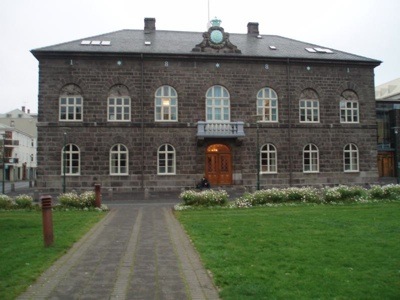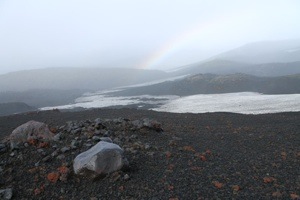A Short History of Iceland
This article relates to Burial Rites

The Republic of Iceland, the setting for Hannah Kent's debut novel Burial Rites, has a deep and intriguing history.
- Located west of Scandinavia and just south of the Arctic Circle, the first confirmed settlement of Iceland was in the 9th and 10th centuries by Norsemen from Scandinavia and Scotland. Though questions remain about the actual events leading up to the settlement, Icelandic tradition suggests Norsemen were fleeing the tyranny of the Norwegian King Harald I Haarfagri. According to early Icelandic records, Celts from the British Isles were among the early emigrants, having been taken as slaves and wives by the Norsemen.
- In 930 a legislative assembly known as the Althing was established (literally all-thing, general assembly). It is one of the oldest legislative assemblies in the world.
 King Olaf I of Norway commissioned missionaries to introduce Christianity to Iceland in 1000. Around this time the religion was adopted by the Althing.
King Olaf I of Norway commissioned missionaries to introduce Christianity to Iceland in 1000. Around this time the religion was adopted by the Althing.
- Iceland was independent until 1262, when a treaty established a union with the Norwegian monarchy. In 1380 Iceland and Norway became part of the Danish crown. In 1537 Norway dissolved as a state (until 1814) and became part of Denmark. Iceland passed to Danish control.
- More than 33 percent of Iceland's population died in 1402 when the Black Plague infected the country. In 1703 the first census recorded Iceland's population at 50,358. Only a few years later the plague invaded again and caused death for one-third of the population.
- By the 19th century the enforcement of capital punishment—a major theme in Burial Rites—came to an end. A convicted murderess was the last person to be executed (by beheading) in 1830. Capital punishment was officially abolished in Iceland in 1928.
- In 1918 Iceland became a full sovereign state united with Denmark under a common king. However, with the German occupation of Denmark in 1940, communications ceased between Iceland and Denmark. Iceland assumed control over its own waters and foreign affairs. British, then American military forces, became responsible for Iceland's defense.
- On June 17, 1944 Iceland became an independent republic, following a referendum in which 97 percent of the population voted to permanently cut ties with Denmark. By 1946 the United States was no longer responsible for Iceland's defense but retained certain rights at the U.S. Navy base at Keflavik International Airport.
- Iceland became a charter member of the North Atlantic Treaty Organization in 1949. This membership did not require the establishment of an Icelandic armed force or the stationing of foreign troops during peace time. With the outbreak of the Cold War and increased global hostilities, Icelandic officials concluded membership in the NATO alliance was not sufficient. Consequently, the U.S. and Iceland agreed that the U.S. would again make arrangements for Iceland's defense. Although a bilateral defense agreement, signed in 1951, remains in force, all U.S. military were withdrawn from the country as of fall 2006, when Naval Air Station Keflavik was closed. Today, Iceland has no standing military force, yet NATO maintains an air policy presence in Icelandic airspace.
- In 1980 Icelanders elected Vigdis Finnbogadóttir to the presidency, the first woman in the world to be elected head of state in a national election. She was reelected three times. (In Iceland, the president is viewed primarily as a figurehead. The office is traditionally ceremonial. The head of government is the prime minister.) Another historic event in this decade was the Reykjavik Summit, when U.S. President Ronald Reagan and Soviet leader Mikhail Gorbachev met in the capital in 1986. A 2007 article published by the Nuclear Threat Initiative described the meeting as "a near successful attempt of leaders of nuclear powers to agree on complete elimination of nuclear weapons."
- From 2008 to 2011 Iceland suffered a major economic and political crisis that involved the collapse of all three of the country's privately owned commercial banks. Consequently, Prime Minister Geir Haarde resigned in January 2009. When Johanna Sigurdardóttir took the helm she signed a stability pact that served as a foundation for economic reconstruction. Sigurdardóttir was Iceland's first female prime minister and the world's first openly gay head of government.
- In April 2012 Haarde was found guilty of one charge related to his negligence that led up to the crisis. After being cleared of more serious charges, however, he did not have to face jail time. The country's financial standing has steadily improved since the crash.
- Iceland is one of the most volcanic regions in the world and is renowned for its glaciers.
 In 2010, eruptions of the volcano Eyjafjallajökull, snarled air traffic across much of Europe. These natural resources have helped Iceland become the world's largest producer per capita of green energy. 65% of its energy needs are met by geothermal energy, a further 20% by hydropower.
In 2010, eruptions of the volcano Eyjafjallajökull, snarled air traffic across much of Europe. These natural resources have helped Iceland become the world's largest producer per capita of green energy. 65% of its energy needs are met by geothermal energy, a further 20% by hydropower.
- Also notable is its literary heritage, particularly the Icelandic Sagas, which include ancient tales of family feuds and heroics. The Sagas were written during the 13th century, considered the "Golden Age." The country's appreciation for stories and the written word continues to this day. Iceland's literacy rate is 99 percent.
For more information about Iceland, read the Beyond the Book written for Arctic Chill.
Top Picture: National Parliament (Althing) Building in Reykjavik
2nd Picture: A view down the southwest flank of Hekla volcano
Pictures from cia.gov
Filed under Places, Cultures & Identities
 This "beyond the book article" relates to Burial Rites. It originally ran in September 2013 and has been updated for the
April 2014 paperback edition.
Go to magazine.
This "beyond the book article" relates to Burial Rites. It originally ran in September 2013 and has been updated for the
April 2014 paperback edition.
Go to magazine.
This review is available to non-members for a limited time. For full access become a member today.
Membership Advantages
- Reviews
- "Beyond the Book" articles
- Free books to read and review (US only)
- Find books by time period, setting & theme
- Read-alike suggestions by book and author
- Book club discussions
- and much more!
-
Just $45 for 12 months or
$15 for 3 months.
- More about membership!

 Book Reviewed by:
Book Reviewed by: King Olaf I of Norway commissioned missionaries to introduce Christianity to Iceland in 1000. Around this time the religion was adopted by the Althing.
King Olaf I of Norway commissioned missionaries to introduce Christianity to Iceland in 1000. Around this time the religion was adopted by the Althing. In 2010, eruptions of the volcano Eyjafjallajökull, snarled air traffic across much of Europe. These natural resources have helped Iceland become the world's largest producer per capita of green energy. 65% of its energy needs are met by geothermal energy, a further 20% by hydropower.
In 2010, eruptions of the volcano Eyjafjallajökull, snarled air traffic across much of Europe. These natural resources have helped Iceland become the world's largest producer per capita of green energy. 65% of its energy needs are met by geothermal energy, a further 20% by hydropower.
![]() This "beyond the book article" relates to Burial Rites. It originally ran in September 2013 and has been updated for the
April 2014 paperback edition.
Go to magazine.
This "beyond the book article" relates to Burial Rites. It originally ran in September 2013 and has been updated for the
April 2014 paperback edition.
Go to magazine.






